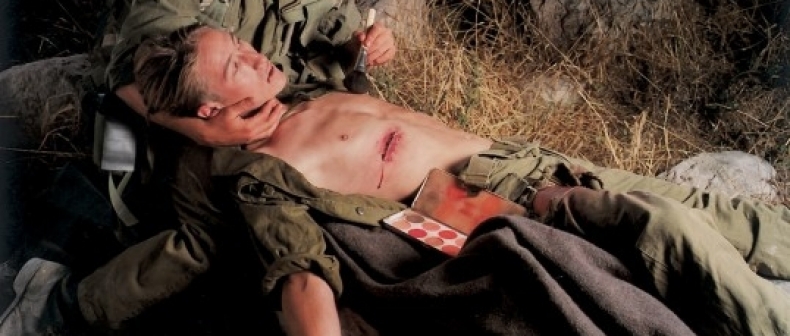
Untitled, by Adi Nes (1995)
A couple of years ago, I was at a public screening of videos by Guy Ben-Ner — an Israeli artist based in New York City — and during the question and answer period, from the back of the room, someone asked about the Israeli/Palestinian conflict and its effect on his work. I heaved a deep inward sigh as Ben-Ner gamely, politely began his answer. I thought the question was pointless and doctrinaire; a cursory glance at Ben-Ner’s work reveals that it has to do with the family unit, domesticity, childhood, games. Neither Israel nor Israeli politics are even remotely involved. To me, that question was not only a non-sequitur, but a dangerous one, as it implied that, for Israeli artists, an engagement with the subject and the content of their work came a distant second to making them beholden to a very specific set of political responsibilities.
This question (and its circumstances and implications) kept hurtling to the front of my mind as I made my way around Adi Nes’ current solo show at the Olga Korper Gallery. The show is one of the spotlight exhibitions of this year’s Contact Photography Festival, and is presented by the Koffler Centre for the Arts. The show is comprised entirely of old work, some stretching back to the very beginnings of Nes’ career. It culls together work from three series: Soldiers (1994-2000), Boys (2000) and Biblical Stories (2004-2007).
Nes has always been heavily interested in quotation. Almost all of these photographs reinterpret Biblical or mythological subjects, and are replete with visual references to other artworks. Soldiers has members of the Israeli military in art-historical pantomime. The centerpiece of the show, Untitled (The Last Supper), is a recreation of the Da Vinci fresco with members of the Israeli Defense Forces standing in for Jesus and the Disciples. Another untitled image from the series is an IDF Pieta; the fictions of the ersatz Christ’s wounds are cheekily highlighted by the presence of a makeup kit off to the side, as the attending medic holds a blending brush.
Boys is a kind of fantasia on male adolescence, and Biblical Stories reenacts foundational Old Testament legends in the slums of Tel Aviv: Abraham and Isaac as itinerant father and son; Cain and Abel as two back-alley thugs; Joseph as a young boy in a dingy multicoloured striped shirt; Hagar recast as a Dorothea Lange image.
Technically and formally, the works are highly accomplished. Compositions are dynamic, their colours saturated by a golden light. There is a drama and pathos to the work, and a sweet longing pervades many of the pictures (Nes is himself queer, and his Boys series is especially pungent with desire). And despite the fact that this kind of cross-referencing game is, by now, a worn-out chestnut of a trope (it’s at least as old as, say, Carravaggio) there is a meaningful resonance in casting about Israel for echoes of the Bible. Still, there’s something profound that’s missing here.
Walking through the gallery, it struck me that a common thread to this decades-spanning work is a startling lack of context. My amble around the show was interrupted by a very polite and congratulatory Q&A with Nes (it was the opening, after all). I longed for that doctrinaire question-poser to suddenly appear; here, finally, was an appropriate venue for their question.
His Soldiers series is billed as an attempt to capture a homoerotic tenderness that underscores military life. But of course, he isn’t dealing with just any military; this is the Israeli Defense Forces. Armies are potent symbols, and the IDF, regardless of one’s opinions on Israeli domestic and foreign policy, stands as a symbol for one of the most politically divisive and ongoing struggles of the last 50-odd years. Granted, mandatory conscription is part of Israeli life, and so all of Nes’ Israeli audience has worn that uniform. Also, this work was created before the Second Intifada, during the longest stretch of domestic peace that Israel has known. Still, these images of soldiers in choreographed poses were never, I think, as simplistically metaphorical as Nes intended, and the passage of time has only complicated them further, rendering them troublingly disingenuous.
This series is by now twelve years old, and Nes has moved on to other things. Yet his work maintains a deep focus on various aspects of Israeli life — adolescence and manhood, urban life (his newest work, Village, is being unveiled at his New York gallery this year), very deliberately set in his home country. Not every Israeli-born artist is bound to address the country’s politics, and even if they do, they are certainly not obliged to be critical. But to be exploring the things that Nes explores — foundational myth, constructs of masculinity in a militarized society — and for the work to remain mum on the conflict that both draws from and affects those concepts so heavily is baffling. There is a silence at the centre of the Koffler’s presentation of Nes’ survey show at Olga Korper, and that silence drowns out anything that the individual works might be saying.
______
Sholem Krishtalka is the Toronto Standard’s art critic.
For more, follow us on Twitter at @torontostandard, and subscribe to our newsletter.











